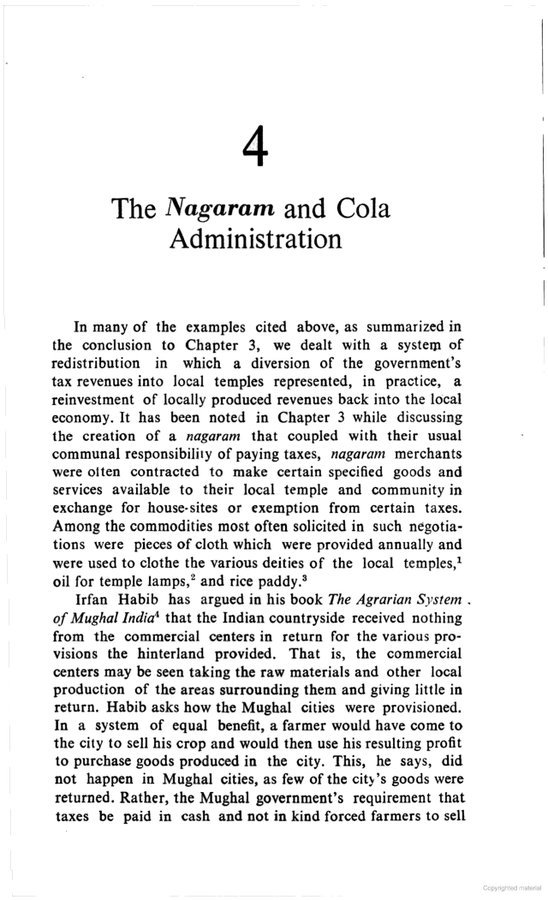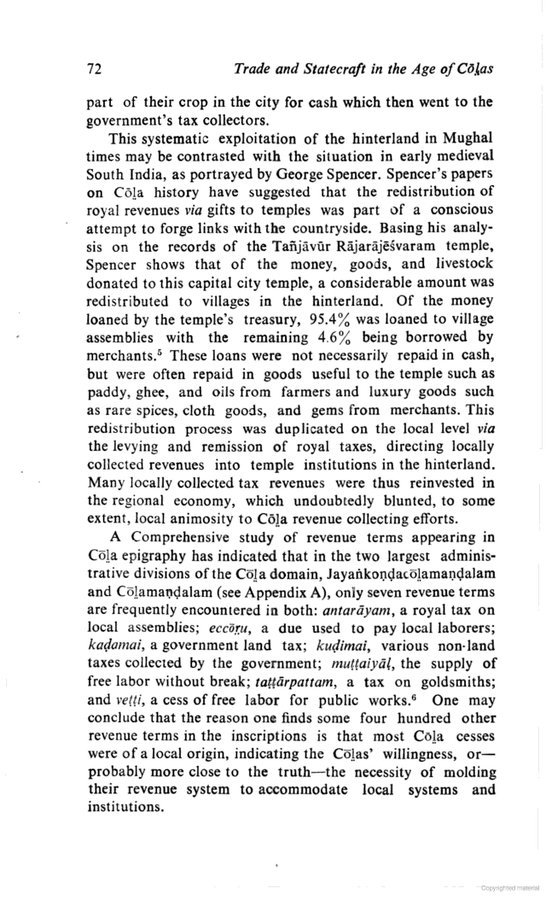The astounding beauty & genius that is cOzha public administration; but first, we need to understand a contrasting, negative experience.

A contrast to the exploitation marking mughal public administration was the community-centered cOzha approach.

More than 95% of the money loaned out from the temple of rAjarAjeshvara (Shiva, named after the king) went to the villages, the countryside. At a time when central incursions into local administration by means of taxes were resented, the conscious reinvesting in local economies served to generate goodwill.

The cOzha administration didn’t involve itself merely in an exercise of taxation & redistribution but also prioritized commercial justice. It saw to it that offenses like misappropriation of funds were swiftly corrected and fines imposed on culprits.

The nagarams, administrative units/teams were semi-autonomous, too, in their commercial and legal operations & more importantly in a Hindu point of view, made the temple the heart of administration by having temple monies deposited with them for investing.

Temples were the biggest investors in nagarams but private citizens of standing could invest as well: money, gold, livestock, etc

What did this mean in practical terms? The monies, gold, livestock, etc. were deposited with a guaranteed rate of interest & were allocated. In this set-up, the temple wealth could be gainfully harnessed without priests themselves getting directly involved in financial activity.

A fully centralized approach to public administration where the iron hand of the state forcefully swings, does not work in reality. rAjarAja 1 realized that lasting goodwill, deeply entrenched public support for the cOzha rAjyam can only be realized by carefully managing both the centralizing tendency natural to ambitious kings & the imperative to partially decentralize by granting autonomy to certain bodies. Monies, gold, livestock, etc. were extremely important part of this sophisticated administrative set-up. But what was the quintessential “medium”, the “language” through which the central (cOzha) administration & the autonomous nagarams “communicated” & dealt with 1 another?
1 word answer: Temples. Again. These commercial/trading nagarams, being granted the autonomy & right to invest, displayed their gratitude to the rAjyam by undertaking, for eg, to contribute the entire income from 1 of the villages in their control to the temple at the capital to the temple at the capital of tanjAvUr, the great temple (bRhadIshvara AKA rAjarAjeshvara).

The scholar referred to in the screenshots Spencer, understands it as a way to cut the ties between local citizens & local institutions. One can also understand its aim as to prevent an unhealthy chasm from developing between the countryside and the capital. It was not an uncommon case in the old world that many commoners in the countryside would have even seen the capital. In my understanding, such transfers by rAjarAja 1 indicate an attempt to facilitate greater integration between the capital and the country.
So what about local temples outside the grand capital? What if the temple did not receive enough paddy income to finance a local ceremony? If insufficient, the officer in charge could raise the required rate of paddy to be returned (the non-cash interest owed to the temple) What if a local temple had a lot of lands under it and consequently excess paddy? It was not wasted. The officer from the capital could excess paddy was utilized for an annadAna ceremony of sorts after presenting it to the deity. The administration of local temples by cOzha:

See, the nagarams are basically trade/investment corporate bodies. and before rAjarAja, a mere part of district-level administrative bodies. Following rAjarAja’s bold administrative reforms and advances, the nagarams were motivated to develop trading links with others outside their own little villages/towns, especially in the capital. Now, these nagarams could directly interact with the rAjyam at the capital. This may raise a question as to whether the nagarams then abandoned their links with the villages or towns they were based in? Though the author does not identify all the issues in one place (as he could have), I have made a few notes based on what I have read so far.
Firstly, it must be admitted that it wasn’t unheard of for nagarams to move away from a village/town to another if situation was really dire. Abandonment of commercial quarters (a modern analogy would be the urban decay of automobile hub, Detroit city) was not unheard of:

Villages/towns were abandoned not just due to bad business but sometimes lawlessness in a particular village.

A new mercantile (nagarattArs) or artisanal (kammALars/vishvakarma-s) community was able to negotiate with the government and acquire residential and cremation lands, free of taxes. Such arrangements helped rejuvenate the local economies. Based on how the author has written, one may be tempted to hold that such commercial bodies/guilds could move at their whim and fancy. I don’t think that is a right supposition. As the cOzhas reformed law & administration, there must have been a proliferation of nagarams and it must have been rather difficult for nagarams to simply abandon their villages/towns and directly compete in the capital.
Coming back to the issue of nagarams which drifted away from local-level bodies (nADu) and interacted with the capital directly they continued to be based in their nativities while expanding the trade volume by having contacts with their counterparts in the capital. Once again, the local nagarams continued to maintain their local links and harbor goodwill with the same medium: the temple.

Merchants continued to play a vital role in dhArmika acts–i.e. A charitable vaishya was in fact called dharmachetti (chetti-shreSTHi, seth).

One can see two seemingly contradictory strands in rAjarAja 1’s “theory” of administration. Firstly, he enabled greater commercial freedom for the nagarams and made it easier for these bodies (Which were the ones really generating revenue) to do business and granted them the autonomy required for such purposes. Secondly, and sort of contrarily, he was unafraid to show power where needed (political consolidation). As one may go through earlier tweets, he compelled the transfer of staff from local temples to periyakovil (bRhadIshvara) at tanjAvUr.
Apart from what the author rightly calls an “impressive show of personal strength”, he also saw that nagarams, whether central or local, were supervised by central-level officers & fines were swiftly imposed on local nagarams for fund misappropriation. Central officers were One notes economic liberalization and ease of doing business limited both by regulations as well as personal power One gets reminded of LKY (Lee Kwan Yun, the late Singapore Premier) whose attitude towards easing up business went hand in hand with a no-nonsense attitude towards troublemakers.
Let’s continue! So let us get more insight into the relationship between the nagarams (Commercial bodies) & their biggest investors-the rAja

Here we see the concept of commercial markets (aNGADi: which, today, would refer to a store/supermaket). But in ancient cOzha usage it referred to proper trading/investment markets where a body corporate or private merchants from other cities/towns/villages and farmers came to buy and sell goods, based on what we have understood about the workings of nagarams thus far.
We see that a pEraNGADi (big market) in the name of tribhuvana mahAdevI (the wife of madhurantaka uttama cOzha) was especially prominent and received special support. It would be interesting to understand the reasons. As mentioned in last para on pg 84, it was the oldest at the time of rAjarAja cOzha. The above inscription records specifically the ratio in which the king’s donations to the temple treasury were allocated to the 4 markets. From the ratio, we see that rAjarAja wanted to invest more in these newly commissioned markets named after him.
Perhaps, a poignant question may arise for some (as it did for me): whether there were commercial entities who were not nagarams? Indeed.

It is unclear from the author as to the exact advantages of being constituted as a nagaram, though one could figure out some of these
- We see above in pgs 84 & 85 that the 4 aNGADis managed by the nagarams were outside the city–This was a special commercial district with perhaps more space available for the markets. After all, the market of tribhuvana mahAdevI is known as a huge one.
- Preferential treatment and increased direct access to royal monies meant increased capacity to trade and invest.
Nevertheless, rAjarAja seems to have engaged the services of non-nagaram institutions, certain artisanal guilds for personal projects.
Perhaps, to those interested in the economic aspects of chOzha greatness, you may want this book by an Indian Hindu author: “Cholanomics: Social Pursuit of Cholas with Temple as Epicentre” Title itself is very telling. Unfortunately, not on Kindle.
Before this thread moves onto other materials/sources and issues, there is a fundamental question which has not been answered or handled directly in this thread thus far. That question is: “Why was the temple chosen to be the cornerstone of the chOzha economic architecture?”
Unfortunately, I had not gone through this directly in the thread but it would seem rather obvious once stated. Temples were the biggest recipient of donations (from the king right down to a farmer whose harvest has done well; even devadAsis donated generously).
As a result, temples were most capable of being “angel investors” for a nADu (local agrarian unit) farmers, merchants, etc. See, a group of poor farmers may hesitate to borrow money from rich merchants/traders (who may reject) & moneylenders (who may exploit).
But they would not have hesitated to borrow from temples to which wealthy individuals & corporate bodies donated generously! This deeply entrenched institution of temple donation in the chOzha empire was perhaps the largest, voluntary & indirect wealth redistribution scheme.
Temples dealt by way of profit-sharing from investments, not usury. So, payment of loans by a poor farmer would be in the form of a reasonable share of yield, to be used by temple to make food or a certain number of sheeps/cows: butter for lamps, milk for kitchen, etc.
Thus, temples enjoyed an unparalleled inflow of capital, a great moral reputation, people did pay owed monies to temple due to immense stigma attached to misappropriation of the god’s monies; so it was overall a sustainable enterprise.
This is how the temple was the centerpiece of the chOzha socio-economic architecture.